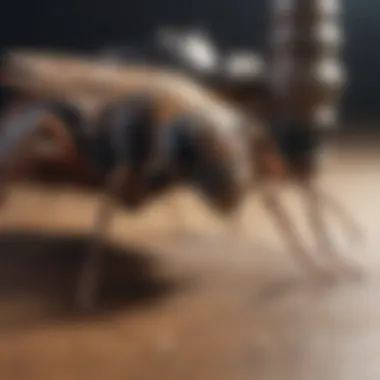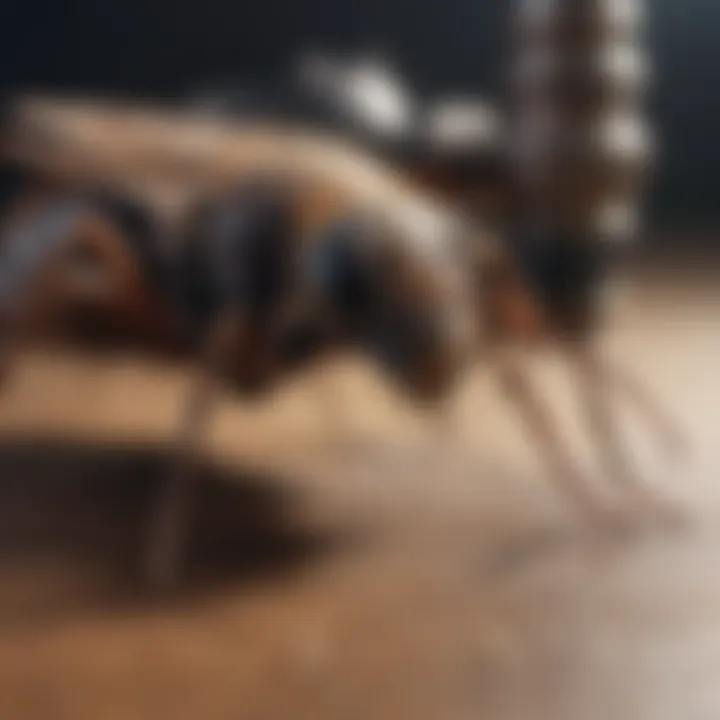Comprehensive Guide to Effective Ant Eradication Strategies


Preventive Pest Control Strategies
Preventive pest control strategies are essential in ensuring a pest-free environment within your home. Starting with House Exterior Protection, it is crucial to seal any cracks or openings that could serve as entry points for insects like ants. Additionally, clearing debris around your property helps eliminate hiding spots for pests. Preventing pests from entering your home can be achieved through measures such as installing door sweeps and repairing damaged screens.
When it comes to Yard Maintenance, regular upkeep is key. Essential yard care routines include mowing the lawn regularly, trimming bushes and trees, and removing any standing water that could attract pests. Implementing methods for keeping your yard pest-free, such as using natural repellents and planting pest-resistant vegetation, can further deter pests from taking up residence on your property.
Maintaining Indoor Cleanliness is vital for pest prevention. Expert cleaning tips and techniques focus on reducing clutter, regularly vacuuming and sweeping, and storing food in airtight containers. Creating a pest-resistant indoor environment involves sealing cracks and gaps in walls, floors, and around pipes to block potential entry points for pests.
Efficient Garbage Disposal is a significant aspect of pest control. Proper waste disposal methods include using covered trash bins, removing garbage regularly, and securing compost piles to prevent attracting pests. Emphasizing the importance of proper garbage disposal can help deter unwanted visitors like ants and rodents.
Exploring Other Pest Prevention Strategies, such as installing mesh screens on windows and vents, using sound or light repellents, and implementing natural barriers like diatomaceous earth, adds layers of defense against pest infestations.
Identifying Pest Risk Areas
In order to effectively combat pest infestations, it is crucial to identify and address potential risk areas within and around your home. Moisture Prone Areas Inspection involves identifying areas with damp conditions, such as basements and crawl spaces, to prevent infestations. Implementing tips like using a dehumidifier and fixing leaky pipes can help mitigate moisture-related pest issues.
A Crack and Crevice Inspection Guide is essential for identifying access points that pests may use to enter your home. Sealing cracks and crevices with caulk or weatherstripping reduces the likelihood of pest intrusion. Regularly inspecting and repairing these vulnerable areas is key to effective pest control.
When it comes to Greenery Inspection for Pest Risks, understanding how landscaping and vegetation can attract pests is crucial. Maintaining a well-trimmed yard, removing dead vegetation, and keeping plants away from the foundation of your home can help prevent pest infestations. Checking for standing water and addressing drainage issues is also important to deter mosquitoes and other water-loving pests.
Considering Additional Pest Risk Areas, such as attics, garages, and outdoor storage sheds, and implementing preventive measures like sealing gaps around utility entry points and storing firewood away from the house, strengthens your overall pest control strategy.
Effective Pest Control Methods
To effectively eradicate pests from your home, a combination of Natural Repellents for Pest Control and Chemical Sprays for Pest Control may be necessary. Safe and effective natural solutions include using essential oils like peppermint or lavender to repel pests, planting insect-repelling herbs like basil or mint, and sprinkling diatomaceous earth as a natural insecticide.
When considering Chemical Sprays for Pest Control, it is essential to follow all safety guidelines and use professional-grade products to minimize risks to human health and the environment. Eradicating pests with chemical solutions should be done sparingly and as a last resort when natural methods have proven ineffective.
Utilizing Pest Traps is another effective method of pest control. Setting up traps in areas where pests are most active, such as along baseboards or near food sources, can help in capturing and removing pests safely. Checking and emptying traps regularly ensures their ongoing effectiveness.
Implementing Biological Control Methods involves introducing natural predators or parasites that feed on pests, such as ladybugs for aphid control or nematodes for grub control. These environmentally-friendly techniques can help reduce pest populations without the use of chemicals.
Exploring Other Pest Control Methods, including electronic repellent devices, ultrasonic pest repellers, and heat treatments for bed bugs, expands your arsenal of pest control options beyond traditional means.
Pest Species Identification
Identifying common pests that plague homes is crucial for implementing targeted pest control measures. Recognizing and managing Common Insects like ants, cockroaches, and spiders involves understanding their behaviors, nesting habits, and preferred environments. By identifying these insects early on, you can take proactive steps to prevent infestations.
Identifying Rodents is equally important in pest prevention. Tips for identifying signs of rodent activity, such as droppings, gnaw marks, and scratching sounds, can help in targeting areas for control measures. Differentiating between mice and rats allows for the implementation of species-specific prevention and elimination strategies.
Addressing the impact of Bird Species on home environments, especially in urban areas, involves mitigating issues like bird droppings, nest building, and noise disturbances. Identifying troublesome bird species, such as pigeons or starlings, and implementing deterrents like bird spikes or netting can help in keeping birds away from your property.
Dealing with Wildlife on Your Property, whether it's raccoons, squirrels, or bats, requires a humane and proactive approach. Understanding the behavior of wildlife species, securing garbage bins, and sealing off potential entry points can help prevent unwelcome animal encounters.
Taking a proactive stance toward Miscellaneous Pest Species Identification, such as pantry pests like moths or beetles, outdoor nuisances like mosquitoes or ticks, and garden pests like aphids or slugs, ensures comprehensive pest control coverage.
DIY Pest Control Techniques
For those inclined towards a hands-on approach to pest control, Homemade Pest Control Solutions offer eco-friendly alternatives to traditional chemical treatments. Creating deterrents using ingredients like vinegar, baking soda, or citrus peels can help in repelling common pests from your home.
Harnessing the power of Essential Oils for Pest Control, such as citronella for repelling mosquitoes or eucalyptus for deterring spiders, provides a natural and pleasant-smelling method of pest prevention. DIY essential oil sprays can be used both indoors and outdoors to create a bug-free environment.
Setting up Effective Pest Traps and Barriers around your property can help in capturing and controlling pests. From sticky traps for crawling insects to physical barriers like copper mesh to deter slugs, there are various options available for home pest management.


Considering Top Reputable Pest Control Brands can provide ready-to-use solutions for addressing pest infestations. Products from trusted brands like Ortho, Raid, or Terro offer reliable pest control measures that safeguard your home and family from unwanted intruders.
Exploring Miscellaneous DIY Pest Control Techniques, such as creating homemade fruit fly traps, using duct tape to capture crawling insects, or employing ultraviolet light traps for flying insects, provides innovative solutions for tackling specific pest problems at home.
By incorporating these comprehensive strategies and methods into your pest control regimen, you can effectively combat ant infestations and maintain a pest-free environment within your home.
Understanding Ant Behavior
Ant behavior is a crucial aspect to grasp when embarking on the journey of ant eradication. Understanding how these tiny creatures operate and interact within their colonies provides valuable insights necessary for effective pest control. By delving into the social structure of ant colonies and their foraging patterns, individuals can develop strategic approaches to combat infestations with precision and efficacy.
Social Structure of Ant Colonies
Ant colonies exhibit a highly complex social structure, consisting of various castes with distinct roles and responsibilities. The Queen Ant plays a central role in reproduction, ensuring the colony's survival and proliferation. Worker ants handle tasks such as foraging, nest maintenance, and caring for the young. Soldier ants defend the colony from external threats, showcasing specialized mechanisms for combat.
Queen Ant Roles
The Queen Ant's primary function revolves around laying eggs, perpetuating the colony's population. Her immense reproductive capacity ensures a steady supply of offspring to sustain the colony. This pivotal role makes the Queen Ant a cornerstone in the ant colony hierarchy, dictating its growth and stability. However, excessive reliance on a single individual for reproduction can also render the colony vulnerable to disruptions in the Queen's health or lifespan.
Worker Ant Functions
Worker ants shoulder the burden of numerous crucial tasks vital to the colony's functioning. From gathering food to tending to the larvae, workers form the backbone of ant societies. Their adaptability and tireless work ethic contribute significantly to the colony's overall success. Nevertheless, the repetitive nature of their duties and susceptibility to environmental changes can pose challenges to their efficiency and longevity.
Soldier Ant Mechanisms
Soldier ants specialize in defense, utilizing physical adaptations and behavioral strategies to protect the colony. Their larger size, potent mandibles, and aggressive nature make them formidable opponents against intruders. Soldier ants act as the frontline defenders, warding off threats and ensuring the colony's safety. However, maintaining a contingent of soldiers also entails diverting resources from other vital colony functions, potentially impacting overall productivity.
Foraging Patterns
The foraging behavior of ants encompasses intricate patterns that influence their search for food sources and navigation within their environment. By understanding the mechanisms behind trail formation and food source identification, individuals can interrupt ant foraging activities and disrupt their access to sustenance, curbing infestation levels effectively.
Trail Formation
Ants communicate with each other through pheromone trails, laying down scent markers to guide their nestmates to food sources. These chemical pathways facilitate efficient resource exploitation and colony coordination. Disrupting trail formation through physical barriers or repellents can impede ant foraging expeditions, hindering their ability to locate and procure sustenance.
Food Source Identification
Ants possess remarkable capabilities in discerning and locating food sources through a combination of olfactory cues and visual stimuli. Their keen sense of smell and memory enable them to revisit profitable foraging sites repeatedly. By understanding how ants identify and prioritize food sources, individuals can implement targeted interventions to obscure, deter, or eliminate these attractants, diminishing ant activity in domestic settings.
Natural Ant Eradication Methods
Essential Oils and Herbs
Lavender Oil
Lavender oil, renowned for its calming aroma, plays a vital role in natural ant eradication methods. Its key characteristic lies in its ability to act as a potent repellent against ants, helping to deter them from infesting living spaces. The unique feature of lavender oil is its pleasant scent, which doubles as a natural insect repellent without harsh chemical odors. However, while lavender oil effectively repels ants, its downside may be its potency in enclosed spaces for individuals sensitive to strong fragrances.
Peppermint Repellent
Peppermint repellent stands out as a powerful tool in the arsenal of natural ant eradication methods. Its distinctive feature lies in its strong minty scent, acting as a natural deterrent that ants find repulsive. The benefits of peppermint repellent extend beyond eradicating ants to promoting a refreshing ambiance in homes. Its unique feature rests in its dual functionality, serving both as a pest control solution and an aromatic enhancer. Yet, a potential drawback of peppermint repellent could be its temporary efficacy, requiring frequent reapplication for sustained ant control.
Neem Extract
Neem extract emerges as a valuable ingredient in the realm of natural ant eradication methods due to its potent insecticidal properties. The key characteristic of neem extract is its ability to disrupt the growth and reproduction of ants, aiding in population control. Its unique feature lies in its organic nature, making it a preferred choice for those opting for chemical-free solutions. However, one potential drawback of neem extract could be its slower action compared to chemical insecticides, necessitating patience for visible results.


Home Remedies
Boric Acid Solutions
When considering home remedies for ant eradication, boric acid solutions offer a potent and versatile approach. The key characteristic of boric acid solutions is their effectiveness in targeting ant colonies at the source, helping to eliminate the entire population. The unique feature of boric acid lies in its low toxicity to humans and pets, making it a safe yet powerful ally in combating ant infestations. However, one must exercise caution in using boric acid solutions near food preparation areas or around children and pets to avoid unintended exposure.
Citrus Peel Sprays
Citrus peel sprays present a natural and aromatic solution in the realm of home remedies for ant eradication. The key characteristic of citrus peel sprays is their citrusy scent, which acts as a deterrent for ants while leaving a refreshing fragrance in treated areas. The unique feature of citrus peel sprays lies in their dual functionality as a pest repellent and air freshener, offering a multi-purpose approach to combating ant infestations. However, a potential disadvantage of citrus peel sprays could be their temporary nature, necessitating frequent reapplication for sustained ant control.
Professional Ant Control Services
Professional ant control services play a crucial role in achieving effective ant eradication. These services offer specialized expertise and resources to tackle ant infestations comprehensively. By engaging professionals, homeowners can benefit from tailored solutions designed to address their specific ant issues. The key elements that make professional ant control services invaluable include their professional assessment, precise treatment plans, and ongoing preventive measures.
Integrated Pest Management
Inspection and Assessment
Inspection and assessment are fundamental aspects of integrated pest management. In the context of ant eradication, thorough inspection helps in identifying the extent of infestation, nest locations, and ant species present. This detailed assessment is vital for developing targeted treatment strategies and ensuring a successful eradication process. The key characteristic of inspection and assessment is the detailed scrutiny of the infested areas, enabling pest control experts to formulate effective eradication plans. Despite being time-consuming, the advantage of thorough inspection and assessment lies in its ability to provide accurate data for customized treatment approaches.
Customized Treatment Plans
Customized treatment plans are tailored solutions crafted based on the findings of the inspection and assessment phase. These plans outline the specific actions to be taken to eradicate ants effectively. The customization factor allows for the implementation of strategies that target the identified ant species and infestation severity. This personalized approach maximizes the efficiency of the eradication process by addressing the root causes of the infestation. The unique feature of customized treatment plans is their adaptability to unique ant infestation scenarios, ensuring a more targeted and precise eradication effort.
Preventive Measures
Preventive measures form a critical component of integrated pest management in ant control services. These measures aim to prevent future ant infestations by addressing conducive conditions and entry points for ants. By implementing preventive measures, homeowners can safeguard their properties against recurring ant problems. The key characteristic of preventive measures is their proactive nature, which focuses on long-term ant control rather than just immediate eradication. While preventive measures require ongoing maintenance, their advantage lies in providing sustained protection against ant reinfestation.
Chemical Treatments
Chemical treatments are another facet of professional ant control services, offering potent solutions for severe ant infestations. These treatments involve the use of specialized insecticides formulated to target ants specifically. When deployed strategically, chemical treatments can effectively eliminate ants from both indoor and outdoor spaces. The components of chemical treatments include insect growth regulators, baiting systems, and barrier sprays.
Insect Growth Regulators
Insect growth regulators are chemicals designed to disrupt the growth and development of ants, ultimately leading to colony suppression. This mechanism inhibits ant reproduction and population growth, reducing the overall ant presence over time. The key characteristic of insect growth regulators is their targeted action on ant life stages, ensuring long-lasting control. While effective, a potential disadvantage of insect growth regulators is the need for thorough application to reach all ant colonies and achieve optimal results.
Baiting Systems
Baiting systems are a popular method in chemical ant eradication, relying on ant bait stations or gels to attract ants and deliver toxic substances. Ants carry these baits back to their colonies, effectively spreading the insecticide within the entire nest. The key characteristic of baiting systems is their ability to target ants at their source, leading to colony elimination. However, the time required for complete eradication and potential bait aversion in certain ant species are considerations to weigh when using this method.
Barrier Sprays
Barrier sprays create a protective perimeter around the property, acting as a deterrent for ants attempting to enter indoors. These sprays contain residual insecticides that repel and kill ants upon contact, serving as a vital line of defense against ant intrusions. The key characteristic of barrier sprays is their long-lasting effect, providing extended protection against ants. A potential disadvantage of barrier sprays includes the need for periodic reapplication to maintain effectiveness, especially in high-traffic ant areas.
Ant Eradication in Agricultural Settings
Ant eradication in agricultural settings is a crucial aspect of pest management in farming practices. Addressing ant infestations in agricultural areas is essential to ensure the health and productivity of crops. By understanding the specific challenges and considerations related to ants in farming, farmers can implement effective strategies to control and eradicate these pests.
Organic Farming Practices
Organic farming practices play a significant role in managing ant populations while promoting a sustainable and eco-friendly approach to pest control.
Beneficial Insects


Beneficial insects are a key component of organic farming practices for ant eradication. These insects, such as ladybugs and lacewings, contribute to natural pest control by preying on ants and other harmful insects. Their presence helps maintain a balanced ecosystem in agricultural settings, reducing the need for chemical interventions.
Beneficial insects are known for their voracious appetites for pests, making them effective allies in combating ant infestations. Their ability to consume large numbers of ants and their larvae makes them a popular choice for farmers looking to minimize chemical usage and promote biodiversity within their farms. However, one disadvantage of relying solely on beneficial insects is that their effectiveness may vary depending on the specific ant species and infestation severity.
Companion Planting
Companion planting is another organic farming practice that can aid in ant eradication by creating natural pest deterrents within the agricultural environment.
Companion planting involves strategically planting different crops together to enhance growth, improve soil quality, and repel pests like ants. Certain plant combinations, such as basil with tomatoes or marigolds with vegetables, can emit scents or compounds that deter ants and disrupt their foraging patterns.
The unique feature of companion planting lies in its ability to create a harmonious ecosystem where plants work together to ward off pests naturally. This method not only reduces the reliance on chemical pesticides but also promotes a more sustainable and holistic approach to pest management. However, it's essential to carefully select companion plants based on their compatibility and effectiveness in deterring ants to maximize the benefits.
Biological Pest Control
Biological pest control methods offer an environmentally friendly and effective alternative to chemical treatments for managing ant populations in agricultural settings.
Predatory Species Introduction
Introducing predatory species into agricultural environments can help control ant infestations by using natural predators to reduce pest numbers.
Predatory species like certain nematodes or spiders are attracted to ants and can prey on them, keeping their populations in check. This approach is beneficial as it aligns with natural ecological processes, reducing the reliance on synthetic pesticides that may harm beneficial insects or disrupt the ecosystem. However, the success of predatory species introduction relies on factors such as environmental conditions and the presence of suitable prey for sustained control.
Microbial Inoculants
Microbial inoculants are another biological pest control method that can aid in ant eradication by targeting ants at the microbial level.
Microbial inoculants are comprised of beneficial microorganisms that compete with harmful pathogens, including those carried by ants. By applying microbial inoculants to the soil or crops, farmers can disrupt ant colonies' ability to thrive and spread. This approach offers a natural and sustainable solution to managing ant infestations without causing harm to non-target species or the environment. However, the effectiveness of microbial inoculants may vary depending on factors such as application timing and environmental conditions.
Sustainable Ant Management Approaches
In the realm of ant eradication strategies, the focus shifts towards sustainable approaches that not only effectively eliminate ant infestations but also prioritize eco-friendly solutions. The importance of sustainable ant management approaches lies in its dual benefit of offering a long-term solution while minimizing the environmental impact. By incorporating sustainable practices, individuals can address ant problems without causing harm to the ecosystem.
Eco-Friendly Solutions
Natural Predators Utilization
Natural predators utilization stands out as a key component of sustainable ant management approaches. This method involves harnessing the power of beneficial insects or other natural predators to control ant populations. The key characteristic of natural predators utilization is their ability to prey on ants without disrupting the surrounding environment. By introducing these predators into the affected area, a natural balance can be restored, reducing ant numbers organically.
One of the primary reasons why natural predators utilization is a popular choice in ant eradication is its non-invasive nature. Unlike chemical treatments, this method targets ants specifically without harming other beneficial organisms. However, a potential disadvantage of this approach is that it may require some time to see visible results, as the predators need to establish their presence and impact on the ant population.
Non-Toxic Repellents
Another integral aspect of eco-friendly solutions in ant eradication is the use of non-toxic repellents. These repellents are designed to deter ants without posing any harm to humans, pets, or the environment. The key characteristic of non-toxic repellents is their ability to create a barrier that ants find unappealing, consequently steering them away from the treated area.
Non-toxic repellents are a beneficial choice for those seeking a safe and sustainable way to manage ant infestations. Their eco-friendly nature aligns with the principles of sustainable ant management, making them a preferred option for environmentally conscious individuals. However, it is essential to note that non-toxic repellents may require reapplication to maintain their effectiveness, which can be considered a minor drawback.
Ant-Repelling Landscaping
In the realm of sustainable ant management, the concept of ant-repelling landscaping plays a significant role in deterring ants from invading living spaces. By strategically choosing plants with deterrent properties and implementing hardscaping strategies, individuals can create an environment that is less hospitable to ants.
Plants with Deterrent Properties
Plants with deterrent properties serve as a natural barrier against ants, emitting scents or substances that repel these insects. The key characteristic of these plants is their ability to act as a natural defense mechanism, discouraging ants from venturing into specific areas. This makes them a popular choice for those looking to enhance their landscaping while maintaining pest control organically.
The unique feature of plants with deterrent properties lies in their dual functionality of beautifying the landscape while serving a practical purpose. However, it is essential to consider the maintenance required for these plants to ensure they continue effectively repelling ants.
Hardscaping Strategies
Hardscaping strategies complement plant-based deterrents by providing physical barriers that hinder ant movements. The key characteristic of hardscaping strategies is their ability to create obstacles that ants struggle to navigate, preventing easy access to buildings or preferred foraging areas.
The unique feature of hardscaping strategies is their long-term effectiveness, as they offer a lasting solution to ant infestations when implemented strategically. However, it is crucial to assess the overall aesthetic impact of hardscaping strategies and ensure they blend seamlessly with the existing landscape to avoid altering the visual appeal of the property.



